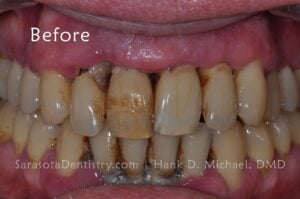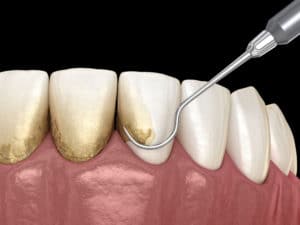How to Get Rid of Black Tartar on Teeth
Tartar can be difficult to remove on your own at home without going to a dentist, but you can still remove it with consistent brushing, flossing and some do-it-yourself gadgets. When not removed from your teeth promptly, tartar buildup can increase your risk for a wide range of oral health problems, including gum disease.
If you have tartar buildup, you should make an appointment with your dentist to have it removed professionally as soon as possible. Sarasota Dentistry offers dental cleaning and scaling and root planing services for those who need help removing tartar buildup and wish to maintain healthy teeth and gums for life. If unable to see a dentist right now, consider the following information to remove tartar naturally at home and prevent future tartar buildup.
Table of Contents
- What is Tartar
- Signs of Tartar Buildup
- How Does Tartar Impact Your Oral Health
- Can You Remove Tartar at Home
- Why You Should Find a Dentist to Remove Tartar
- Ways to Prevent Tartar Buildup
- FAQs About Tartar
What Is Tartar?
Tartar, also known as calculus, comprises the buildup of plaque and minerals that harden (calcify) on teeth. Tartar builds up between teeth and on the fronts and backs of teeth, feels crusty to the touch, and presents a yellow or brown hue. Tartar results from eating foods high in sugar and starches and by brushing and flossing fewer than two times per day. Tarter build-up is also specific to the each persons body chemistry. Some people will build excessive tarter while brushing and flossing three times per day while others brush only once and have no signs of tarter. Stress, age and the health of the immune system are significant factors affecting the presence of calculus build up in the adult population.

Signs of Tartar Buildup
Tartar that builds up above the gum line may be yellow, tan, or brown and often spreads to cover a larger portion of teeth when not removed. Tartar that builds up below the gum line may be brown or black and may lead to receding gums, bone loss, and/ or periodontal disease. Other signs of tartar buildup include bad breath, irritated and bleeding gums, tooth sensitivity, and cavities. Gums may also be raised and bright red due to inflammation.
How Does Tartar Impact Your Oral Health?
Tartar buildup poses a detrimental effect on your oral health, eventually leading to chronic bad breath, gingivitis, cavities, gum disease, bone loss and eventually tooth loss. Tartar can be extremely difficult to remove without professional treatment and increases the risk for a wide range of other health problems when left unaddressed. For instance, gum disease triggered by tartar buildup increases the risk for diabetes, heart disease, and stroke, as reported by the Department of Health and Human Services.
Can You Remove Tartar At Home?
Tartar may be removed at home using one or a combination of natural remedies. Flossing and brushing twice per day may help loosen and remove tartar, especially if you use an electric toothbrush. Using baking soda toothpaste may also remove tartar — given the abrasiveness of baking soda. In a study published in the Journal of Clinical Dentistry, researchers learned that those who brushed their teeth with baking soda toothpaste had less plaque growth within 24 hours than those who used non-baking soda toothpaste.
Other at-home remedies for tartar removal include oil pulling and using a high-powered water flosser. Plastic dental scalers are also available over the counter and can be used to remove some larger blocks of tarter and calculus. Most of these at home remedies for tarter removal don't remove the final and most important layer of tarter on the tooth and therefore are relatively ineffective at preventing gum disease. Professional cleanings by a licensed dental hygienist utilizing sharp scalers is critical to successfully remove calculus/tarter and help prevent gum disease.

Why You Should Find a Dentist to Remove Tartar
Though possible to learn how to clean tartar off teeth on your own, the process can often take several months or years when you do it at home. Brushing and flossing only remove tartar gradually over time, as does oil pulling and using a water flosser. A dentist and dental hygienist has professional cleaning tools and expertise needed to remove tartar completely within just a few convenient, dental visits.
A dentist can effectively remove tartar from hard-to-reach spots and has greater visibility to remove tartar when compared to you attempting the same feat, standing in front of the bathroom mirror. A dentist also has dental hygienists who can give additional assistance as needed. A dentist can not only remove tartar effectively but can also screen you for more serious conditions such as gingivitis or gum disease through a comprehensive exam.
Ways to Prevent Tartar Buildup
Brushing and flossing at least twice per day can help you prevent tartar buildup. Seeing a dentist regularly every six, four, or three months… or as needed, can also prevent tartar buildup as your dentist will scrape away any existing plaque and tartar and use fluoride treatments that help with prevention.
Other steps you can take to prevent tartar buildup include reducing your intake of sugar, increasing your intake of fresh fruits and vegetables, and chewing gum that contains sorbitol or xylitol as opposed to real sugar. These behaviors can help reduce the number of bacteria in your mouth that contribute to tartar buildup.
FAQs About Tartar
How Can You Tell if You Have Tartar Buildup?
Tartar, usually yellow or brown, feels crusty to the touch and tends to grow between teeth, behind teeth, and in front of teeth. You cannot often remove tartar with one brushing and flossing session. Dr. Hank Michael at Sarasota Dentistry can confirm whether you have tartar buildup and remove it during your appointment.
What is Tartar (Calculus) on Teeth?
Tartar comprises the buildup of plaque on teeth and occurs due to infrequent brushing and flossing, eating foods high in sugar, and using tobacco products. When left untreated, tartar can increase the risk for additional oral health problems, including gingivitis and gum disease.
Is Tartar Bad for Your Teeth?
Tartar contributes to worsened oral health as it may lead to bad breath, loss of enamel, cavities, gum disease, and tooth loss. Tartar should be removed as soon as possible to maintain good oral health.
What Causes Tartar Buildup on Teeth?
Tartar buildup can be caused by a wide range of factors, including smoking, chewing tobacco, and eating a high amount of sugary foods. Brushing and flossing infrequently may also contribute to tartar buildup. Stress, age and genetics are also strong contributing factors to tarter build up.
Can You Get Rid of Tartar on Teeth at Home?
Tartar may be removed at home with regular brushing and flossing or with a water flosser. Oil pulling — using coconut oil or olive oil — may also help remove tartar at home. These methods may be effective at removing tartar; however, a dentist can remove tartar in a more timely manner. Sarasota Dentistry uses scaling and root planing to effectively remove tartar buildup. The hygienists use either and ultrasonic scaler or a hand scale with dental curettes to remove calculus and tarter.
- Author
- Recent Posts

Dr. Michael and his staff focus on providing painless dental services in a welcoming atmosphere. His dental expertise includes general dentistry, dental implants, cosmetic dentistry, oral & I.V. sedation, full mouth reconstruction, teeth bleaching, veneers, laser dentistry, metal-free crowns, inlays/onlays, and dentures to enhance both your health and appearance.

How to Get Rid of Black Tartar on Teeth
Source: https://www.sarasotadentistry.com/dental-blog/how-to-remove-tartar/